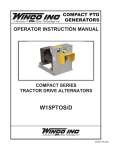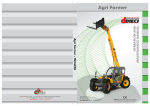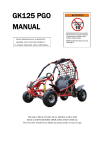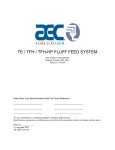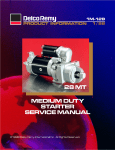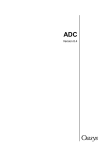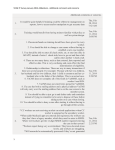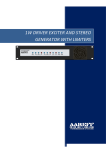Download manual - Winco Inc.
Transcript
Chassis Mount PTO Generators OWNERS MANUAL INSTALLATION AND OPERATION INSTRUCTIONS ECV2510-3 ECV2512-3 SIDE VIEW TOP VIEW Note: Unit shown is the ECV2512 the only dimension that changes on the ECV2510 is the location of the input shaft DRIVE END VIEW SAFETY FIRST READ THIS MANUAL BEFORE OPERATING YOUR GENERATOR. 60706-130 Read and understand all instructions in this manual before starting and operating the generator set. USING THIS MANUAL PROPER USE AND INSTALLATION Congratulations on your choice of a Winco generator. You have selected a high-quality, precision-engineered generator set designed and tested to give you years of satisfactory service. To get the best performance from your new generator, it is important that you carefully read and follow the operating instructions in this manual. Should you experience a problem please follow the “Things To Check” near the end of this manual. The warranty listed in this manual describes what you can expect from WINCO should you need service assistance in the future. You must be sure your new generator set is: * Properly serviced before operating * Operated in a well ventilated area * Exhaust gases are dispersed safely * Wired by a qualified electrician * Operated only for its designed purposes * Used only by operators who understand its operation * Properly maintained TABLE OF CONTENTS INTRODUCTION GUIDE TO PRODUCT SAFETY BASIC INFORMATION Description PREPARING THE UNIT Unpacking the unit Assembly INSTALLATION Plan the Installation Mounting Ventilation Drive Line & Lubrication Pre-Wire Checklist Initial Start ELECTRICAL CONNECTIONS FINAL SYSTEM CHECK MAINTENANCE General Information Periodical Maintenance Generator Maintenance Lubrication TROUBLE SHOOTING TABLE PART LIST Automatic Voltage Regulator Generator Parts List Gear Box Part List WIRING DIAGRAM 12 MONTH WARRANTY i 1 2 2 2 2 3 3 3 4 4 4 5 5 5 5 7 8 9 10 12 13 14 COPY YOUR MODEL AND SERIAL NUMBER HERE No other WINCO generator has the same serial number as yours. It is important that you record the number and other vital information here, if you should ever need to contact us on this unit it will help us to respond to your needs faster. MODEL____________________________________ SERIAL NUMBER____________________________ PURCHASE DATE____________________________ DEALER___________________________________ 3. SAFETY INFORMATION This generator set has been designed and manufactured to allow safe, reliable performance. Poor maintenance, improper or careless use can result in potential deadly hazards; from electrical shock, exhaust gas asphyxiation, or fire. Please read all safety instructions carefully before installation or use. Keep these instructions handy for future reference. Take special note and follow all warnings on the unit labels and in the manuals. a. b. 4. b. 5. b. d. Use only factory approved replacement parts. Do not work on this equipment when fatigued. Use extreme caution when working on electrical components. High output voltages from this equipment can cause serious injury or death. Always avoid hot mufflers, exhaust manifolds, and engine parts. They all can cause severe burns instantly. ELECTRIC SHOCK- The output voltage present in this equipment can cause a fatal electric shock. This equipment must be operated by a responsible person. INSTALLATION- Installing a PTO generator is not a “do-ityourself” project. Consult a qualified, licensed electrician or contractor. The installation must comply with all national, state, and local codes. a. a. b. c. d. e. f. g. 2. Remove all grease, ice, snow or materials that create slippery conditions around the unit. Remove any rags or other material that could create potential fire hazards. SERVICING EQUIPMENT- All service, including the installation or replacement of service parts, should be performed only by a qualified technician. a. b. c. 7. 1. Use hearing protection equipment when working around this equipment for long periods of time. Keep your neighbors in mind when permanently installing this equipment. CLEANLINESS- Keep the generator and surrounding area clean. a. 6. Operate only in well ventilated areas. Never operate indoors. NOISE HAZARD - Excessive noise is not only tiring, but continual exposure can lead to loss of hearing. a. ANSI SAFETY DEFINITIONS ______________________________________________________ DANGER: DANGER indicates an imminently hazardous situation which, if not avoided, will result in death or serious injury. This signal word is to be limited to the most extreme situations. ______________________________________________________ ______________________________________________________ WARNING: WARNING indicates a potentially hazardous situation which, if not avoided, could result in death or serious injury. ______________________________________________________ ______________________________________________________ CAUTION: CAUTION indicates a potentially hazardous situation which, if not avoided, may result in minor or moderate injury. It may also be used to alert against unsafe practices. ______________________________________________________ NOTE: CAUTION is also used on the unit labels and in this manual to indicate a situation that could result in serious damage or destruction of the equipment and possible personal injury. ______________________________________________________ DEADLY EXHAUST GAS - Exhaust fumes from any engine contain carbon monoxide, an invisible, odorless and deadly gas that must be mixed with fresh air. Do not allow anyone to operate the generator without proper instruction. Guard against electric shock. Avoid contact with live terminals or receptacles. Use extreme care if operating this unit in rain or snow. Use only three-prong grounded plugs and extension cords. Be sure the unit is properly grounded to an external ground rod driven into the earth. Do not make or break electrical connection under load. b. c. 8. OPERATION - PTO drive shafts (Tumbling Bars) have many inherent dangers, extereme caution must be exercised when using them. a. FIRE HAZARD- Gasoline, diesel and other fuels always present a hazard of possible explosion and/or fire. b. a. c. Keep a fire extinguisher nearby and know its proper use. Fire extinguishers rated ABC by NFPA are appropriate. d. e. f. 60706-130 Page 1 Never operate the PTO drive generator without having it properly mounted. Never connect the PTO generator to an existing electrical system without installing an isolation transfer switch. Always insure the drive shaft is straight and level before operating the generator. NEVER allow children around a drive shaft when it is in operation. Keep all safety guards and shields in place and securely tightened. Never operate a drive shaft that has been damaged or had the safety shield removed. Never step over a drive shaft while it is running. Never wear a necktie, loose articles of clothing, or anything else that can be caught in moving parts. Never try to stop a turning drive shaft with your hand or your foot. 7150-01 DESCRIPTION The WINCO ECV2510/2512 PTO drive generator will provide 120/240V single phase, 60Hz electrical service when direct-driven. The ECV2510 requires a 1000 RPM input shaft speed and the ECV2512 requires a 1182 RPM input shaft speed. NOTE: The prime mover which drives the generator must be capable of delivering approximately 2 HP per 1000 watts output from the generator. Observe input RPM specifications. When loss or damage is noted after delivery, segregate the damaged material, and contact the carrier for claim procedures. “Concealed damage” means damage to the contents of a package which is not evident when the package is delivered by the carrier, but which is discovered later. The carrier or carriers are responsible for merchandise lost or damaged in transit. The title to the goods rests with the consignee when the goods are shipped FOB factory, and only the consignee can legally file claims. Two years are allowed in which to file suit after a claim is disallowed in writing by the carrier. The generator may be under chassis mounted and driven from a truck transmission with a PTO drive installed in it. This generator is a rotating armature design with compound field coil windings. Normal excitation is accomplished via the "Q" winding in the armature and a full wave bridge rectifier. An automatic voltage regulator is installed on the generator to maintain the correct voltage when the unit is under load. To reduce maintenance problems, the coupling between the generator input shaft and rotor consists of precision helical gearing rather than a chain link drive. The input shaft is 1-1/8 in diameter smooth shaft with a key way and center drilled for a roll pin. Both must be used at all times. WINCO thoroughly tests each of these generators before shipment. All are continuous duty rated. IMPORTANT: THE MANUFACTURER STRONGLY RECOMMENDS RUNNING THE GENERATOR UNDER LOAD AT LEAST ONCE A MONTH IN ORDER TO EVAPORATE ANY ACCUMULATED MOISTURE CONDENSATION INSTALLATION ******************** ********WARNING* ********* ********************* Before proceeding with the installation, be sure the drive line and engine are disabled and cannot accidentally operate while the generator is being installed. Before beginning the installation process recheck the voltage power rating and physical size and drive line rating and speed, horsepower etc. Be certain they can handle the intended load and are compatible with the required vehicle equipment voltage, phase and current ratings. Plans for installation should be prepared with proper attention to mechanical and electrical engineering detail to assure a satisfactory system installation. The information in this manual is offered as a guide to finalizing your installation plans. The installation sequence is summarized below: A. Plan the installation : 1. Space required for installation and service access. 2. Protected location, close to electrical connections. 3. Mounting frame. 4. Clear of moisture and dirt. 5. Shielded from excess heat and cold. B. C. D. E. F. G. H. Mounting the generator system. Clear, protected source of ventilation of generator. Drive line aligned within 5 degrees (10 degrees max). Pre-wire system check. Initial system start-up. Generator electrical power connections. Final system check UNPACKING CAUTION: Equipment Damage DO NOT invert generator during unpacking. The Gearcase contains oil which will leak out if inverted during unpacking. Unpack the generator as follows: 1. Remove the carton. 2. Inspect the generator carefully for freight loss or damage. If loss or damage is noted at time of delivery, require that the person making the delivery make note of the loss or damage on the freight bill, or sign the consigner’s memo of the loss or damage. Contact the carrier for claim procedures. 3. Remove the four bolts which hold down the generator feet to the pallet. 4. Lift the generator from the pallet by means of the lifting eye on the top of the generator. 7150-01 A. PLAN THE INSTALLATION 1. Space Required. The space required should allow for ample working room around and in back of generator. A general rule to follow is 12 inches minimum clearance all around the unit. This allows a service person to repair and remove generator parts in the event service is needed. In general, all service can be performed from the rear generator cover or the front gear case. Page 2 60706-130 2. Location. Locate as close to electrical service as possible. This will reduce the cost of electrical and minimize the losses in the power conductors. Position the unit to keep clear of the drive line and exhaust runs. 3. Mounting Support. Frame loading, frame type and strength should be taken into consideration when installing an emergency rescue generator under a truck. 4. Moisture and Dirt. Protection from adverse weather conditions and road spray must be provided without restricting adequate ventilation for cooling. All electrical equipment should be protected from excessive moisture. Failure to do so will result in deterioration of the insulation and will result in short circuits and grounds. Foreign materials such as dust, sand, tint and abrasive materials have a tendency to cause excessive wear, particularly the brushes. It is important that the unit be installed in a reasonably clean location for best service life. Careful planning will eliminate costly rework. 5. Heat and Cold. All generators radiate considerable heat when they are running. In addition, these units are generally mounted in a somewhat restricted location which precludes natural cooling. Allow space for cooling air to sweep across the generator shell. It is important that the temperature of the ambient air around the unit not exceed 105 degrees Fahrenheit while operating. Additional cooling louvers or fans may be necessary if adequate cooling flow is not naturally provided. B. MOUNTING THE GENERATOR SYSTEM The generator should be bolted solid to a heavy steel cross channel or plate. It is recommended that the generator be mounted on a steel sub-frame which facilitates easy removal of the generator for better service access to the chassis or for generator repair. Shock mounting the generator or mounting frame is generally not recommended do to possible harmonic vibration, drive misalignment and mounting stress. Make sure the drive shaft (tumbling bar) is assembled with its universal joint knuckles “synchronized,” as illustrated in. If knuckles are not synchronized, the bar will chatter when rotating, which will cause the generator output voltage to flicker. C. VENTILATION OF GENERATOR This is an air cooled generator. This unit is equipped with a suction fan to cool the armature and field coils. Therefore it will be necessary to insure that the hot air discharge plume gets out of the mounting area. D. DRIVE LINE AND LUBRICATION Check gear case oil level. Case should be filled with oil to plug marked “OIL LEVEL.” Fill or remove oil as required. NOTE: EITHER TOO LITTLE OR TOO MUCH OIL CAN HARM THE EQUIPMENT. See “Lubrication” portion of Maintenance for oil specifications. 60706-130 Page 3 7150-01 The PTO drive shaft should be maintained in as straight a line as possible. Install the generator so the drive line is aligned to within 5 degrees (10 degrees Max). The 2510/2512 PTO units will require about 50 Hp to maintain full output, be sure that the auxiliary drive on the vehicle transmission and the gear reduction box is capable of the expected mechanical load. It is generally recommended that the drive shaft be balanced to minimize drive line vibration and stress. Make sure no binding exists in generator or gear box. If binding is found, locate the cause and correct it before proceeding *****Notice ***** E. PRE-WIRE SYSTEM CHECK: G. GENERATOR ELECTRICAL POWER CONNECTIONS WARNING: Personal Injury When working on or around these generators, do not wear loose fitting clothing or any articles that may get caught in moving parts. ALL wiring should be done by a licensed electrician, and should conform to the national electrical code and with state and local regulations. Before wiring the generator to the distribution load circuits, the installation and operation of the drive system and generator should be checked to insure proper drive line, engine and generator operation. Use the following check List to verify correct installation before starting the engine: 1. 2. 3. 4. 5. Drive line straight and tight. Unit mounting base and hardware solid and bolts properly torqued. Ventilation clear and protected. Clearance on all sides and service access on both ends Generator output leads protected from grounding. F. INITIAL START AND TEST PROCEDURE CAUTION: Make sure that all tumbling bar lock pins are engaged and that all safety shields are in place before operating the PTO generator. 2. See vehicle manufacturers instructions for operating procedures. The generator should be turning at specified rpm and producing correct voltage and frequency. If the generator fails to operate as specified, stop the engine and refer to the trouble shooting section of this manual. With the engine running smoothly, and at the desired speed, check the no-load voltage and frequency. Generator leads G1 to G3, should read 240 Volts nominal(240 TO 255 volts). Leads G1 to GN, and G3 to GN both should read a nominal 120 volts(120 to 127 volts) at 60 Hz. It may be necessary to adjust the voltage regulator to obtain the proper voltage. The voltage regulator is located on the left hand side of the generator end cover. Final voltage adjustments must be done on the voltage regulator. The regulator may not effect the no-load voltage to any degree. 7150-01 After verifying the voltage and frequency are correct, prepare for final wiring of the generator by disabling the drive system and or engine. The generator can now be connected to the load circuits. The generator power output leads are marked G1(A & B) , G3(A & B) and GN(A & B). We use parallel leads from the generator to reduce the wire size and make them eaiser to handle. The A & B wires are always paired together. A main line circuit breaker must be installed in the load distrubution panel on the vehicle. The G1 and G3 wires are routed to the mainline circuit breaker in the distribution panel. The neutral lead GN is run to the neutral terminal in the distribution panel. Note! Most codes require that the neutral conductor be “bonded”’ (grounded directly to the frame of the generator). Check local codes to insure compliance. Refer to the national electrical code NEC for portable/ mobile equipment. No further electrical connections are required. After completing the above checklist, the generator is ready for the initial start-up test. 1. If for any reason during the check-out procedure the voltage and frequency are not correct, stop the engine and refer to the troubleshooting procedures. The load current carrying wires must be sized to handle the maximum load current without excessive voltage drop. By NEC code, conductors must be heavy enough to handle the full current rating of the main line circuit-breaker (or fuse) in the load distribution panel protecting the conductors. All wires should be installed in rigid or flexible conduit. Because of the many different types of wiring service, feeder, and distribution panels used on rescue equipment, no specific wiring instructions can be provided. ************* *****WARNING****** ************ If auxiliary (shore/commercial) power may also be connected to the load for demonstration, training or alternate source power, an isolation switch must be installed. An isolation switch will prevent feed back of commercial power into the generator or generator power into commercial line. When the load is connected to the generator there must be absolutely no feedback from the generator to the power line or from the power line to the generator during any operating condition. When correctly connected, the design of the wiring control system prevents an possibility of feedback. Improper installation can create a serious hazard that could result in equipment damage, serious personal injury or death. Page 4 60706-130 H. FINAL SYSTEM CHECK 1. 2. 3. 4. 5. 6. Recheck voltages at mainline circuit breaker. Voltages should match readings taken at the pre-wire checkout. If problems are noted, consult troubleshooting section or factory. Turn on the mainline circuit breaker. Turn on each load individually first, to insure that each load will work properly. Turn on all the loads and recheck voltages. It may be necessary at this time to adjust the voltage using the voltage regulator mounted on the generator end cover to obtain the proper full load voltage. Turn off all the loads and make sure that the no-load voltage has stayed within the proper range. If all voltages and frequencies stay within the proper range, this completes your initial start up procedure. is recommended that the generator be operated at least monthly under normal loads to familiarize operators with the procedures and controls as well as to dry out any accumulated condensation or other moisture in the generator electrical windings. The maintenance and service attention invested will insure getting the peak performence that was designed into the unit. Routine preventive maintenance minimizes costly repairs and generator down-time. Before each use, inspect the generator: gear case oil level should be correct, cooling vents and screens should be clear, and generator mounting hardware should be tight. Clean and inspect the generator after storing it for long periods, and after using it in extremely dusty conditions or in severe weather, such as rain or blowing snow. Generator Maintenance OPERATION A. Brushes Since the generator is self excited and externally regulated, there is no need for operational controls for the generator. Once the regulator is set it should never have to be adjusted. The vehicle manufacturer will provide operation manual for the governor operation and control panel operation. MAINTENANCE General Information The main components of the generator are: armature, field coils, cooling fan, brushes, brush holder assembly, end brackets, rectifier and voltage regulator. Before performing any maintenance on the generator, isolate and/or disable the drive system so the unit can not be accidentally started while being repaired. Under ordinary circumstances, brushes will operate for extremely long periods without requiring replacement. They should be inspected after the first 500 hours of operation, and after every 200 hours of operation thereafter. Remove brushes one at a time and check for length; be sure that each moves freely in the brush holder. Brushes should be replaced when worn down to 3/8”. Replace brushes in complete sets, never singly. When replacing brushes, be careful to reconnect the lead wires properly. Poor contact (or “skipping”) between brush and slip ring is caused by oil and grit, flint, or other hard substance on the brush, or by the brush not being properly shaped to fit the slip rings. Remedy these defects by fitting the brushes to the slipring curvature. Place # 00 sandpaper under the brushes with the abrasive side to the brushes, and work it back and forth until the brushes are the same shape as the slip-rings. B. Slip rings The troubleshooting chart lists various symptoms of poor generator operation with possible causes and the appropriate corrective action. You will need a volt-ohm meter or test light to check some of the causes. For some of the other causes you will need to check generator speed. To check generator speed you can use a frequency meter, a tachometer, or a 120V-60Hz electric clock and a correctly operating wrist watch. (Run the electric clock on generator power and compare the clock’s second hand movement with that of the wrist watch. They should run at the same speed. If clock runs faster, generator speed is too high, and vice versa.) CAUTION: Equipment Damage Most electrical equipment in North America operates satisfactorily at frequencies between 59 and 61 Hz (cycles per second.) Operating the generator at frequencies outside that range may cause damage to the generator and/or to electrical equipment driven by the generator. The four continuous copper rings located on the end of the armature are the generator output slip rings. For proper generator output, the surface of the slip rings must have a smooth, shiny, highly polished finish. Normal brush seating will transfer a shiny black finish that will seat the copper surface. This finish should not be removed unless it becomes dull or begins to build up. Under sustained use, it is advisable to check and if necessary, polish the ring surfaces with a crocus cloth to maintain the smooth finish. C. Testing generator fields for opens and grounds. 1. 2. Periodical Maintenance Service/maintenance items include periodic external physical inspection for missing hardware or damage to mounting or drive system and checking the oil level in the gear case. It 60706-130 Electrical Testing 3. Page 5 Disconnect field leads from rectifier. Set multimeter to read resistance, and connect the meter leads to the field leads. If field is open, meter will read infinite resistance (very high ohms). Repair or replace field if it is open. Typical resistance for these fields vary from 17.1 to 18.8 ohms. Leaving one meter lead connected to the field, connect the other meter lead to the field shell. If meter indicates 7150-01 1. Remove all brushes. 2. Ground fault test - set multimeter to read high resistance (meg-ohms).Holding one meter lead against a clean spot on the armature shaft, touch the other lead to each of the slip rings (one at a time) while observing the meter. If meter indicates continuity (any reading lower than one meg- ohm), the armature is grounded. Dirt between the slip rings and on the insulator surface can cause grounding. If grounding was indicated, carefully clean all dirt off the slip rings and their insulators and then recheck it. Replace the armature if it is grounded and unrepairable. 3. Open Test. Set meter to read low resistance (R x 1 ohms). Holding one meter lead on surface of slip ring No. 1, touch other meter lead to surface of slip ring No. 2 while observing the meter. Meter should indicate continuity (low resistance - less than one ohm is typical). If the meter indicates open circuit (infinite resistance) part of armature winding is open. This may be caused by a repairable defect in the connection at the slip ring, however generally an open armature will have to be replaced. Continue reading the continuity between slip ring No. 2 to No. 3 and No.2 and No.4. All the slip rings should have continuity to slip ring number 2, the neutral ring. continuity (any reading -should be infinite resistance). The field is grounded and should be repaired or replaced. To determine which of the fields is grounded, cut the connec tor between the two coils and retest to determine which coil has the low resistance path. Testing Rectifiers 4. Disconnect field leads (F1 & F2) from regulator. 5. Set multimeter to read resistance, and connect the meter leads to the field leads. If field is open, meter will read infinite resistance (very high ohms). Repair or replace field if it is open. Typical resistance for these fields vary from 11.2 to 12.1 ohms. 6. Leaving one meter lead connected to the field, connect the other meter lead to the field shell. If meter indicates continuity (any reading -should be infinite resistance) the field is grounded and should be repaired or replaced. To determine which of the fields is grounded, cut the connec tor between the two coils and retest to determine which coil has the low resistance path. The field excitation is supplied through a full wave bridge rectifier. This type of rectifier has four terminals, two AC, a DC positive and a DC negative. A rectifier may be tested in the following manner: 1. Disconnect all leads from rectifier. 2. Connect the red ohmmeter lead to the positive DC (+) terminal. 3. Connect the black lead to each of the AC terminals in turn. Either a high or low resistance reading will be obtained. Testing the Armature for Opens and Grounds 7150-01 Page 6 60706-130 4. Reverse the meter leads, (black lead to the DC POS (+) and red to the AC terminals, each in turn. An opposite reading should be observed. The drive shaft (tumbling bar) requires greasing. Keep the universal joints in the coupling shaft free from grease and dirt buildup. 5. Connect the red ohmmeter lead to the negative DC (-) terminal. NOTE: Do not over lubricate the universal joints. 6. Connect the black lead to each of the AC terminals in turn. Either a high or low resistance reading will be obtained. 7. Reverse the meter leads, (black lead to the DC NEG (-) and red to the AC terminals, each in turn. An opposite reading should be observed. Check each terminal to the case. An open circuit (very high resistance) reading should be observed. A battery pow ered test light is used. Follow the same procedures described above. A good diode element will allow current to pass to the light in the test lamp when the leads are connected in the forward direction. Check the generator gear case oil level before each use of the generator. Maintain the oil level at oil level plug height. (See page 3 for oil level plug location.) The generator is shipped with lubricant in the gear case. Specifications for gear case lubricant are: 8. 9. If the rectifier fails any of the above tests, it should be considered defective and replaced. API Service: GL-5 Grade: SAE 85W-9O-140 Amount: 1 pint The following kinds of oil are recommended for use in the generator gear case: Mobil SAE 85W90-140 API Service GL5, Sunoco/DX XL80W90-140 Kendal Three Star 85W-140, Amoco 85W140 or equivalent. CAUTION: Equipment Damage Condenser Testing Condensers are built into the generator circuit to minimize radio interference during operation. If a condenser shorts out, it will also short out the generator output. To determine whether a condenser is shorted, stop the generator and disconnect the condenser lead wire from the brush holder. Using a multimeter on the R x 100 scale, check the resistance of the condenser. Normal response is a sharp swing of the meter towards low resistance and then a steady rise towards high resistance (open circuit). If the capacitor is shorted it will show as a constant low resistance. Otherwise, restart the generator without the capacitor connected to recheck the generator for output. If the generator then provides power, the condenser was at fault and should be replaced. (If the generator doesn't provide power, the problem was not caused by that condenser, reconnect the lead wire). If these tests have not located the trouble, remove the armature and have it tested for opens, shorts, and grounds on a growler. Do not overfill generator gear case. Overfilling causes overheating and oil seal failure. Change the oil at least once every six months. Change it more often if you use the generator in bad weather. Use the following procedure to change generator gear case oil: 1. Remove gear case breather. Soak breather in cleaning solvent, then allow it to dry. 2. Remove oil level check plug. 3. Remove the oil drain plug, drain the oil into a clean oil resistant container, 1 quart or larger. Check the oil for metal. Fine metal dust in the oil does not indicate trouble, but metal chips do. Dismantle the gear case and look for damaged gears if you find metal chips in the oil. 4. Replace the oil drain plug. Refill the gear case through the breather port with new oil of the recommended type. Fill the case up to oil level check plug height. (It will take about 1 pint.) 5. Replace the oil level check plug. 6. Replace the breather. 4. Lubrication The generator bearings are factory lubricated and sealed, and require no further lubrication. The generator input shaft should be cleaned and lubricated with a thin film of grease before installing the drive shaft and each time it is removed. 60706-130 Page 7 7150-01 TROUBLE SHOOTING TABLE SYMPTOM CAUSE(S) No output voltage. CORRECTIVE ACTION 1. Circuit breaker open. 2. Defective voltmeter. 3. Short circuit in the load. 4. Loose (or broken) wires or connections in control box. 5. Defective rectifier. 6. Dirty slip rings. 7. Brushes binding in holders. 8. Shorted or open field coils. 9. Shorted or open armature. Low voltage. 1. Engine speed too slow. 2. Generator overloaded. 3. Inadequate engine horsepower. 4. Incorrect field excitation. (No-load output low.) 5. Defective voltage regulator. 1. Reset circuit breakers, replace if defective. 2. Check output with another meter, replace meter if defective. 3. Disconnect the load. Check voltage at cord set. Check motors, appliances and load leads for short circuit. Repair short. 4. Remove panel cover and check all wiring and connections. Tighten and/or repair where necessary. 5. Test rectifier. Replace if defective. 6. Clean and polish. Use 00 sandpaper or crocus cloth, never use emery paper. 7. Check brushes for swelling; replace defective brushes; clean brush holders. 8. Measure coil resistance. Replace coils if open or shorted. 9. Measure between slip rings for open or shorts. Replace arm if defective. 1. Check engine speed. Increase RPM if necessary. 2. Reduce load if it is higher than the rated capacity of the generator. (See generator nameplate). 3. Generator requires 2 HP/1000 watts output. 4. Check for worn brushes and weak or broken brush springs; replace as required. Check input AC voltage to rectifier. Check rectifier output DC voltage to positive DC brush. If no DC voltage is present at the brush, replace the rectifier. Check for dirty slip rings. Clean them if they are dirty. 5. Check regulator for output. Repair or replace as required. High voltage. 1. Engine speed too fast. 1. Check engine speed for correct input RPM. 2. Voltage regulator set too high. 2. Have qualified service technician adjust the regulator. Output voltage flickering or fluctuation. 1. Tumbling bar (coupling shaft) 1. Reduce tumbling bar misalignment to less than 15 degrees. misalignment. 2. Engine speed not constant. 2. Engine governor may be worn or improperly adjusted. Set or repair defective governor. 3. Tumbling bar U-joints not 3. Reassemble tumbling bar. synchronized. Excessive vibration. 1. Power take-off misalignment 1. excessive. 2. Loose mounting nuts and bolts 2. or hold-down studs. 3. Universal joints in coupling 3. shaft worn or dry. 4. Defective bearings. 4. Correct misalignment. It should be less than 15 degrees. Tighten mounting nuts and bolts; repair hold-down stud mountings. Repair or replace defective parts. Check for possible causes. Replace defective bearings. Generator overheating. 1. Poor ventilation. 2. Generator overloaded. 3. Shorted turns in field or stator windings. 1. Clean ventilation and cooling fan screens. 2. Reduce load, then check voltage and current. 3. Replace defective components. Oil leak. 1. Loose plug in gear case. 2. Defective seal, gasket, or plug in gear case. 1. Tighten plug. 2. Replace seal(s), gaskets or plugs. Maintain correct oil level. . 7150-01 Page 8 60706-130 AUTOMATIC VOLTAGE REGULATOR ASSEMBLY REF DESCRIPTION QTY PART NBR 001 002 Voltage Regulator Mounting Bracket 1 1 98884-002 64790-000 003 004 Grommet Machine Screw 1 2 9336-000 16165-000 005 006 Lockwasher Flat Washer 2 2 484-000 598-000 007 008 Hex Nut Sleeving 2 2 6372-000 64620-002 009 010 Circuit Breaker Cover 1 1 91286-003 64791-001 60706-130 Page 9 7150-01 GENERATOR ILLUSTRATION 7150-01 Page 10 60706-130 GENERATOR REPLACEMENT PARTS LIST REF DESCRIPTION QTY 001 002 003 Cap Screw 5/16”-18x2 3/4 Lockwasher 5/16” Lockwasher Split Type ¼” 4 4 3 004 005 006 Machine Screw Lockwasher 11/16 Int. Flat Washer 007 008 009 PART NBR. REF DESCRIPTION 51101-000 480-000 479-000 420 430 431 Hex Nut Armature Assembly Armature 1 1 1 20160-000 64794-000 64794-001 3 1 1 45633-000 40552-000 21867-000 432 Bearing 440 Field Shell & Coil Assembly 441A Field Coil 1 1 1 50215-000 61368-002 64787-000 Lockwasher Hex Nut 1/2-20 Lockwasher 1 1 2 20039-000 9549-000 636-000 441 B Field Coil 442 Pole Shoe 443 Pole Shoe Retainer 1 2 2 64787-001 43473-000 43474-000 010 011 012 Cap Screw 1/2-13 x 1 Machine Screw Lockwasher 1 4 5 48178-000 44342-000 6376 -000 444 447 448 1 12 1 61153-001 24981-000 23478-000 013 014 015 Hex Nut 8-32 Machine Screw Cap Screw 7/16-20 x1 3/4 5 28 7 5113-000 40746-000 43781-000 449 Brush “Q” 460T Brush Rack Assembly 460B Brush Rack Assembly 2 1 1 53949-000 53977-000 53977-001 016 400 401 Cap Screw 7/16 -20 x 1 1/2 Generator Fan Assembly 1 1 1 54806-000 61367-002 23404-000 462 463 467 Brush Holder Condenser Rectifier 12 3 1 23500-002 41221-000 91452-000 411 412 413 End Bracket Oil Seal Bearing 1 1 1 51046-003 46912-000 46913-000 468 469 470 Ground Strap Spacer Brush Holder Spacer 1 14 2 41387-007 23532-000 52559-000 414 415 416 Retainer Plate Gasket Spacer 1 1 1 44318-000 20136-000 20137-000 471 472 491 Mounting Plate Brush Holder “Q” End Cover 6 2 1 53975-000 23500-000 55438-023 417 418 419 Pinion Gear Key Lockwasher 1 1 1 46545-000 20159-000 20139-000 610 N/I Base Wiring Harness 1 1 51147-000 64543-000 Field Shell AC Brush Lead Shield QTY PART NBR. N/I - Not Illustrated TECHNICAL DATA Generator Specifications: kW - 20; Volts -120/240; Amps - 83; PH - 1; Hz -60; Input - 1000/1182 RPM; Generator - 3600 RPM Resistances: Field Coils (rectifier circuit) 17.1 - 18.8 Ohms; Excitor Volts - 92, Amps 2.4 Field Coils (regulator circuit) 11.2 - 12.6 Ohms; Excitor Volts - 55, Amps 2.8 (full load) Armature (Q Winding) .080 - .088 Ohms, (G1 to N & G3 to N) .025 - .0275 Ohms 60706-130 Page 11 7150-01 1000 RPM 1181 RPM PART NBR. 54661-001 44833-000 20029-000 64562-000 PART NBR 64557-000 N/A 20029-000 64562-000 1 4 1 1 46296-000 1774-000 44832-000 20016-000 64556-000 1774-000 46546-000 20016-000 N/A N/A N/A N/A REF 130 134 137 138 DESCRIPTION Gear Box Assembly Pinion Gear Seal Bearing 140 141 142 144 Shaft (Input Drive) Woodruff Key Gear (input Drive) Gasket (Cover) 146 147 148 149 Backing Plate Safety Shield Gear (Driven) Bearing 1 2 N/A N/A 46546-000 54665-000 150 151 152 153 Gasket Retainer Gasket Retainer 1 1 1 1 46299-000 46295-000 46298-000 46286-000 46299-000 64580-000 N/A N/A 154 155 156 Snap Ring Gear Case & Cover (Matched) Breather 1 1 1 20133-000 54662-000 40716-000 N/A 64558-000 40716-000 157 158 Shaft (Driven) Roll Pin 1 1 20128-000 4133-000 N/A 4133-000 7150-01 QTY 1 1 1 2 Page 12 60706-130 60706-130 Page 13 7150-01 WINCO CHASSIS MOUNT PTO GENERATORS 12 MONTH/500 HOUR STANDARD LIMITED WARRANTY WINCO, Inc., warrants for 12 months or 500 hours which ever occurs first from date of shipment, that it will repair or replace at its option, for the original user, the whole or any part of the product found upon examination, by WINCO at its factory at 225 South Cordova Avenue, Le Center, Minnesota, or by any factory-authorized service station, to be defective in material or workmanship under normal use and service. For warranty service, return the product within 12 months from the date of shipment, transportation charges prepaid, to your nearest factory-authorized service station or the WINCO factory. There is no other express warranty. To the extent permitted by law, any and all warranties, including those of merchantability and fitness for a particular purpose, are limited to 12 months from date of shipment, and liability for incidental or consequential damages or expenses is excluded. Some states do not allow limitations on the duration of an implied warranty, and some states do not allow the exclusion or limitation of incidental or consequential damages, so that above limitation or exclusion may not apply to you. This warranty gives you specific legal rights; you may have other rights which vary from state to state. This warranty is limited to bench labor and parts only, no allowance will be made for travel time, or removal and reinstallation in the truck body. This warranty covers only the generator as it was delivered to the Original Equipment Manufacturer. WINCO does not warrant drive lines, or certain other component parts of the product installed by others, since such items are warranted by their manufacturers. WINCO does not warrant modifications or alterations which were not made or authorized by the WINCO factory and which affect the stability or reliability of the product. WINCO does not warrant products which have been exposed to misuse and/or negligence or have been involved in an accident. WINCO does not warrant products which have been installed in such a manner as not to protect them from the adverse environmental conditions (water, mud, insects, etc.) or have not been kept clean. WINCO reserves the right to change or improve its products without incurring any obligations to make such changes or improvements on products purchased previously. 60706-130 225 South Cordova Avenue Le Center, Minnesota 56057 507-357-6821
















